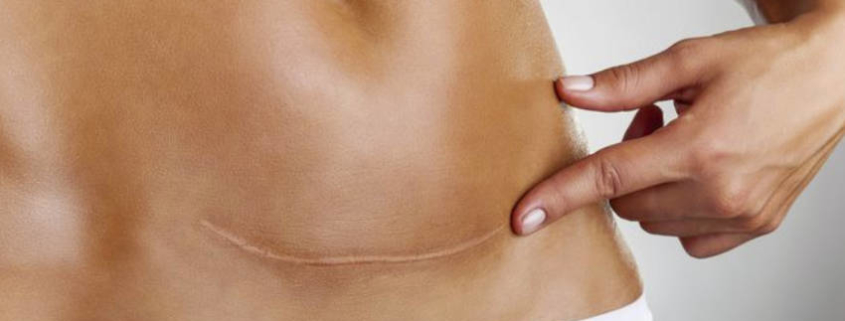Osteopathic Scar Tissue Release
A scar may give the appearance that the body has healed, and whilst the body is efficient at mending itself some scars can be problematic. Scar tissue is never as functional as the original tissue it has replaced. With the exception of very minor scars.
A scar can be as a result of surgery (Caesarean section, appendectomy, cosmetic surgery, joint surgery), an accident or injury (wounding, muscle tears or tendon ruptures), burns, sores, skin conditions or diseases.
During the healing process scar tissue and adhesions can be created, causing pulling and tethering to the surrounding tissue (fascia) which encases the muscles and organs creating restricted movement or altered function in the body. These restrictions not only affect the joint, limb or surrounding area, but they can affect the underlying organs, too. This is because scar tissue has the potential to spread in anydirection, including internally, throughout the body resulting in compensation patterns. The same thing happens in the human body when scar tissue forms. Tissue that used to be able to stretch and flex easily now becomes tight and restricted, with limited range of motion. The resulting pull affects everythingthroughout the body that is even remotely connected to that tissue.
These structural changes can cause pain, nerve impingement, numbness, limited range of motion and flexibility, postural imbalance, muscle weakening and wasting, reduced tissue oxygenation and an increase in potential for future injury. Scar tissue can even act like a dam disturbing drainage oflymphatics and circulation and impacting on our normal physiology and our health.
Seeking professional care for health concerns is important to help understand symptoms. Osteopaths work with patients to treat and identify scars and adhesions, helping to decrease pain and try and return the soft tissues to a more functional state. An osteopathic approach to scar tissue and associated adhesions will not only address the area of pain, but they will also assess the overall body function and look at the history and contributing causes to the symptoms that are occurring.Osteopathic scar tissue release will help manually to unwind, soften and improve a scar. Releasing a scar and adhesion not only works on a physical level but may also help on a psychological level.
Osteopaths addressing scar tissue early in its development can help minimize any of the secondary scar tissue problems. Osteopathic scar tissue release is a way of dealing with the long-term complications and pains caused when the fascial matrix is compromised by the tension of scars.
During the treatment it is common to feel discomfort as scar tissue adhesions are being broken up and fascial tension released and restored. This process aids to reduce the scars and adhesions once the wound is healed. In some cases, a person’s body does not breakdown the scar tissue. The adheredtissue continues to spread which can trigger a cascading effect of compensations throughout the body.
Releasing the scar aims to improve mobility, diminish complications and decrease pain often associated with scars. When a scar has been released there is no longer a restriction in the flow of energy, blood circulation and lymph drainage. The body can then complete the healing process.
“All…nerves go to and terminate in that great system, the fascia.”
A.T.Still M.D. – Founder of Osteopathy
By addressing fascial adhesions and lesions (scar tissue) in the body, it’s possible to remove chronic pain held in our bodies. 85% of all our nerves live in the Fascia.
View a list of common complains that Osteopathy can assist with
Discovery the benefits of Osteopathy
- What is Osteopathy?
- Adult health issues
- Babies and Children
- During and after pregnancy
- Common Complaints
- Testimonials
- Sports Injuries
- Genral Osteopathy FAQs
- The Science & Reasearch



